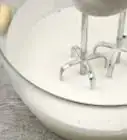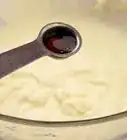This article was co-authored by Maha Mohamed. Maha Mohamed is a Custom Dessert Artist and the Owner of Sweet Treats SJ. Maha has over ten years of experience creating custom treats for special occasions. She specializes in custom cakes, cupcakes, cookies, and chocolate-covered treats.
This article has been viewed 125,100 times.
If your buttercream frosting isn't as thick as you'd like, there are several ways you can easily fix it. Try putting the frosting in the fridge to see if it will thicken up on its own, or add other ingredients like sugar, butter, or cornstarch to thicken up the buttercream frosting. If you're adding more of an ingredient to the frosting, always use small amounts and mix it in thoroughly for the best results. By finding a solution to your buttercream frosting problem, you'll be left with smooth, yummy frosting.
Steps
Thickening the Frosting
-
1Chill the frosting to thicken it without adding more ingredients. Sometimes all your frosting needs is some time to cool down. Place the buttercream frosting in the refrigerator for 30 minutes to an hour to help it thicken.[1]
- This is especially important if you’re working in a warm kitchen.
- Check the frosting after 30 minutes to see if it has thickened by sticking a spoon in it and stirring it around.
- Putting the frosting in the fridge will also help it thicken if the frosting was over-mixed.
-
2Use powdered sugar to easily thicken the buttercream frosting. Add the powdered sugar 1–2 US tbsp (15–30 ml) at a time. Mix the powdered sugar into the frosting using an electric mixer or handheld whisk, making sure it’s thoroughly integrated. If the frosting still isn’t as thick as you’d like, continue adding more powdered sugar in small increments.[2]
- You’ll know the frosting has thickened when it sticks to a spoon without dripping when you lift the spoon out of the bowl.
- It’s best to add the extra powdered sugar in small amounts to make sure you don’t end up adding too much.
Advertisement -
3Add cornstarch in 0.5 tsp (2.5 ml) increments to thicken sweet frosting. If your buttercream frosting is already fairly sweet, try adding cornstarch to it as a thickening agent instead of powdered sugar. Add the cornstarch 0.5 tsp (2.5 ml) at a time, mixing it in thoroughly with a mixer or whisk until the frosting starts to thicken.[3]
- Avoid adding more than 1 US tbsp (15 ml) of cornstarch to the buttercream frosting, or the frosting will have a starchy flavor.
-
4Mix 1 US tbsp (15 ml) of butter into the frosting to thicken it without altering the taste. Soften the butter before adding it to the frosting, making sure that it’s not entirely melted — or the buttercream can become even more runny. You can do this by leaving it out at room temperature for a couple hours, or by putting it in the microwave for roughly 20 seconds. Use a mixer or spoon to combine the added butter to the frosting until it starts to thicken.
- Melting the butter too much before pouring it into the frosting will mess up the frosting’s consistency. If your butter has turned into a liquid, it's too melted.
- Press down on the stick of butter using a spoon. If the spoon moves through the butter easily, it's ready to go into the frosting.
Fixing Other Frosting Issues
-
1Mix the frosting faster or for a longer amount of time to fix the consistency. If you’re using an electric mixer, increase the speed and mix the frosting for another 1-3 minutes. If you’re mixing the frosting by hand, hold the bowl steady with one hand and begin mixing the frosting with the other hand using a spoon or whisk, using fast hand movements.[4]
- If you’re mixing the frosting by hand, try mixing it for at least 3-5 minutes to see if it starts blending better.
-
2Balance out too-thick frosting by adding 1 US tbsp (15 ml) of milk. If your buttercream frosting is too thick and won’t spread, try adding 1 US tbsp (15 ml) of milk at a time. Stir the milk into the frosting, adding more if needed until you reach your desired consistency.[5]
- Stir the milk into the frosting for at least 10 seconds before deciding whether or not to add more.
-
3Heat the bowl using a hairdryer if your frosting is curdled. Plug in a hairdryer and set it to warm heat. Blow the warm air on the sides of the bowl of frosting, moving slowly around the whole bowl. Mix the frosting as you heat it, watching for the ingredients to combine properly.[6]
- If your frosting curdled, it’s likely because one or more of the ingredients weren’t at room temperature before you combined them.
-
4Microwave a scoop of the broken frosting before pouring it back in to fix it. If your frosting’s ingredients aren’t blending well, scoop out 1 cup (240 ml) of the frosting and place it in the microwave. Heat it for 5-10 seconds and pour it back into the frosting mixture. As you stir it all together, the frosting should start to blend together nicely.[7]
- Mix the warmed frosting into the regular mixture on a medium speed if you’re using an electric mixer.
- If one of your ingredients is significantly colder than the others, they’re not going to mix well together, creating a cottage cheese-like product instead of smooth buttercream frosting.
References
- ↑ https://www.biggerbolderbaking.com/perfect-frosting-stiff/
- ↑ https://www.youtube.com/watch?v=VvIXpU2Z6Fg#t=35s
- ↑ https://bakingbites.com/2013/09/how-to-thicken-frosting/
- ↑ https://www.thekitchn.com/recipe-rescue-how-to-save-a-br-69323
- ↑ https://www.biggerbolderbaking.com/perfect-frosting-stiff/
- ↑ https://www.youtube.com/watch?v=-b0hjOnuWRk#t=49s
- ↑ https://www.cakecentral.com/tutorial/35890/fix-broken-buttercream


















































